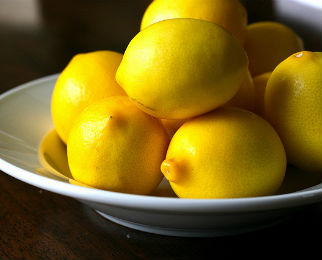Published: February 16, 2015

Written by Sue Campbell, Kendal at Oberlin's Community Nutritionist
It is February! The hustle and bustle of the holidays is long gone. I look out my window at a blanket of snow and run to my car in single-digit temperatures. This time of year can be very peaceful and carries a sense of renewal as we begin a new year.
However, I still find myself dreaming of warm breezes and signs of life outdoors. Last week while working in the kitchen on a particularly cold night, I reached for a lemon in my fruit bowl. I closed my eyes and inhaled. There it was … summertime. Images of lemonade stands and sunshine came to my mind. It may sound simple, but these little things can help to boost our outlook at this time of year when we can’t have the real thing. A bit of aromatherapy can go a long way.
Great Ways to Use Lemons
So, let’s talk some more about lemons. They have an endless number of uses ranging from cleaning stainless steel appliances to bleaching stains out of clothes and tablecloths. My favorite use for them is in cooking, of course. Lemons add fresh and zesty flavor to your savory soups, salads, pastas and desserts. For those of you with diet and weight loss resolutions, lemons have the added bonus of being fat-free and sodium-free. Recent research completed at Johnson and Wales University, which was commissioned by Sunkist, shows that using lemon juice and lemon zest can allow you to reduce the amount of sodium added to your favorite recipes without sacrificing flavor.
A Salt Alternative?
Using lemons instead of salt to flavor dishes can cut sodium as much as 75% without compromising taste. There are lots of sources of sodium found in our food supply. Restaurant and processed foods are the main culprits. The CDC reported--based on a national survey conducted on 35,000 individuals from 2003-2010--that each American consumes an average of 3400 mg of sodium per day.
However, the American Heart Association recommends that we consume less than 2300 mg/day. If you are over 50, have high blood pressure, diabetes or kidney disease, that recommendation lowers to 1500mg/day. Cooking with less salt is definitely helpful in treating these conditions and it is something we can control.
The folks at Johnson and Wales found a formula using lemons in place of salt to reduce sodium in a recipe as noted in the table below:
|
Dish |
If original recipe calls for: |
Replace it with: |
It will reduce salt by: |
|
Vegetables |
1 tsp salt |
¼ tsp salt ½ tsp lemon zest 2 ½ tsp lemon juice |
75% |
|
Pork or Fish |
1 tsp salt |
½ tsp salt+ 1 tsp lemon zest+ 5 tsp lemon juice |
50% |
|
Grains Group |
1 tsp salt |
2/3 tsp salt 1 ½ tsp lemon zest 3 T lemon juice |
30% |
|
Beef or Chicken |
1 tsp salt |
2/3 tsp salt 1 1/3 tsp lemon zest |
30% |
Source: Sunkist S’alternative
 Written by Sue Campbell
Written by Sue Campbell
Kendal at Oberlin's Community Nutritionist





